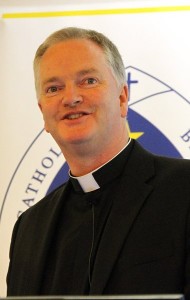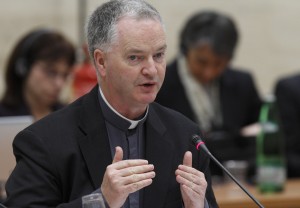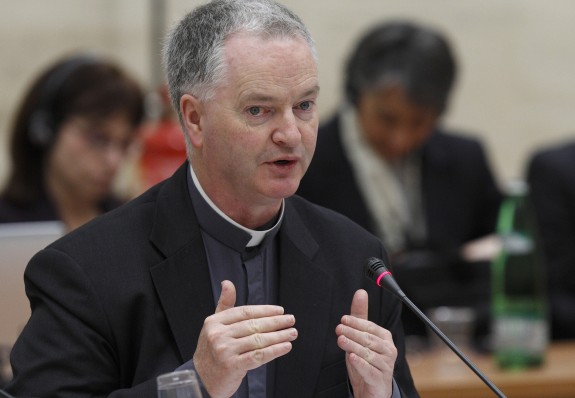Following up my interview with Archbishop Claudio Celli, president of the Pontifical Council for Social Communications, today I’m excited to share my chat with Monsignor Paul Tighe, secretary of the same Council.
 Monsignor Tighe is a gracious, eloquent priest with an Irish brogue and a keen grasp of modern media. He was instrumental in many of the Vatican’s recent digital work including the News.va website, the papal twitter account, and the special Vatican Blogger Meeting. I constantly refer to him as “the Vatican’s new media guy” since he understands technology, practically and philosophically, as well as anyone in Rome.
Monsignor Tighe is a gracious, eloquent priest with an Irish brogue and a keen grasp of modern media. He was instrumental in many of the Vatican’s recent digital work including the News.va website, the papal twitter account, and the special Vatican Blogger Meeting. I constantly refer to him as “the Vatican’s new media guy” since he understands technology, practically and philosophically, as well as anyone in Rome.
During the recent Catholic Media Conference, Msgr. Tighe sat down with me to discuss one of the Vatican’s biggest moves this year, namely the purchase of the new “.catholic” domain name. Watch or read below!
(Like my interview with Archbishop Celli, this one was filmed on an iPad in a crowded hallway. It’s a little noisy, and sounds as if someone is being guillotined in the background, but don’t be alarmed. If you miss any of Msgr. Tighe’s insights, you’ll find the full transcript below.)
Video
Topics Discussed:
0:43 – Why did the Vatican purchase “.catholic”?
2:22 – The Vatican’s enthusiasm over the acquisition
3:27 – How can people apply for a domain under “.catholic”?
4:37 – Why “.catholic” is an investment in the future
4:58 – Msgr. Tighe on the Digital Church Conference
Transcript
BRANDON: Right now I have the pleasure of interviewing Msgr. Paul Tighe, who is the Secretary for the Pontifical Council for Social Communications. Msgr. Tighe was really instrumental in the big news from this past week, which was the Vatican’s purchase of a new top-level domain name, which is “.catholic.” The new domain name will bring in parishes, dioceses, and Catholic organizations into a domain that can be trusted across the Catholic world.
So Msgr. Tighe, welcome! I was hoping you could tell me a little about the Vatican thinking behind this purchase. Why is this such a good thing for the Church?
MSGR. TIGHE: I suppose the hardest thing in this discussion has been trying to explain to people what a top-level domain name is. It’s that bit [of the web address] that comes after the dot. Traditionally, there were geographical domain names associated with countries and then there were the generics [such as] “.com”, “.net”, and “.org.”
About five years ago, ICANN (Internet Corporation for Assigned Names and Numbers), which is the group which structures and organizes the Internet, decided to go with a liberalization process which would allow applicants to seek any string of letters after the dot. The first reaction within the Church was a kind of concern that maybe it would be better not to open that process to religious terms and names, because there are [troublesome] certain contexts, which you can imagine, such as which community would best buy “.jesus”? Or, as we’re going to see over the [upcoming months], which community should own “.islam” or “.church”? We also mentioned [to ICANN] we were worried about “.catholic,” but the advice wasn’t taken. The decision was to ahead with the liberalization and, for freedom of speech reasons, not to exclude any categories. And that was fair enough.
 We thought again about it, and at that stage, it seemed to us that certainly where “.catholic” was concerned, we were the community most indicated as having a right to purchase that domain name. Also, one thing that struck us was we didn’t want somebody else buying it. And more importantly, we became enthusiastic because the digital arena, the digital space, is increasingly important for the life of the Church—for our ministry, for our outreach. This, in a sense, is our way of being able to establish, in a very formal and institutional way, our presence in the digital arena.
We thought again about it, and at that stage, it seemed to us that certainly where “.catholic” was concerned, we were the community most indicated as having a right to purchase that domain name. Also, one thing that struck us was we didn’t want somebody else buying it. And more importantly, we became enthusiastic because the digital arena, the digital space, is increasingly important for the life of the Church—for our ministry, for our outreach. This, in a sense, is our way of being able to establish, in a very formal and institutional way, our presence in the digital arena.
So we became quite enthusiastic about the possibility of being able to have a space in the digital arena where people can go, Catholics and non-Catholics, and be certain that the institutions they find there are authentically Catholic institutions.
Our hope is that this will become a way of authenticating the Catholic presence online and also, in time, to become a way of streamlining our presence. Thankfully we have a very strong Catholic presence, but maybe by bringing it all under the one roof we have the possibility, eventually, of being able to support, encourage, and strengthen one another in our ministries so that, in a sense, we create a communion online which reflects the communion that is at the heart of our community and institution.
BRANDON: How does the Council foresee the logistics of the domain name? How are people going to apply to fit under this top-level domain?
MSGR. TIGHE: We had to do our application [to ICANN] and our application is open for public scrutiny. Anybody who reads it will realize very quickly that we haven’t committed ourselves to a huge amount. What we’re interested in doing in the first stage—and all you had to do in the application is talk about to whom you would give the second-level domains—is we’re going to confine those to dioceses, to recognized international religious orders, and to some apostolic activities.
 Then we will [decide] how to go further. And we’ll do that by selecting a number of bishops’ conferences, asking them to work with us and, once we go out from the diocesan level, see how we need to set up those structures.
Then we will [decide] how to go further. And we’ll do that by selecting a number of bishops’ conferences, asking them to work with us and, once we go out from the diocesan level, see how we need to set up those structures.
[The Pontifical Council is] only twenty people. The team working on this was only three people. We brought in some of the expertise we needed to satisfy ICANN about the technical capacities, but in terms of the actual working out of the project, this is an investment in the future. This is something that will enroll over five to ten years, and we will do this together with the stakeholders, with the communities who make up the Church. We’ll grow and learn together how best to get into the mechanics of it.
BRANDON: Before we go, you sat in for a little bit of our Digital Church Conference, and I’ll you the same thing I asked Archbishop Celli. Why is a conference like that so good for the Church at this point in time?
MSGR. TIGHE: I think something like this is very important to the Church. The Church has recognized, in theory, the significance of the digital arena. But many Church leaders are not native digital people. I love the expression I heard recently: a bishop was talking about new media, and one of the young people said, “You know, you speak new media with an accent.”
Most of us are immigrants; we’re coming into this space. It’s not our natural arena. What I thought was very good [about the Digital Church Conference] was you had people leading it who are enthusiastic for the possibilities, people who are fully-versed and immersed in that world, who know about the technologies but more importantly have reflected and thought, “What fits? What works? What is appropriate? What is inappropriate?”
Just to have the people there encouraging others to not be afraid—as you said yourself, didn’t you?—taking the key words from John Paul II, “do not be afraid!”
I think the key is we’re learning a new language. The only way you learn a language is by being willing to make mistakes. If you’re afraid of making mistakes, you’ll never learn a language. One of the things you did today was encourage people to try it, do their best, and the mistakes can teach us as much as the successes.
As an aside, another reason I love Msgr. Tighe is that he gave me the VIP ticket which got me on the Vatican’s roof last year. The occasion was Pope John Paul II’s beatification ceremony, which drew more than one million people to Rome:
If you liked this discussion, you can find several more on my Interviews page. Be sure you don’t miss future interviews by subscribing to the blog via feed reader or email.
What do you think about the “.catholic” domain name?
(Image Credits: Associated Press, Catholic Weeklym Salt and Light TV)

